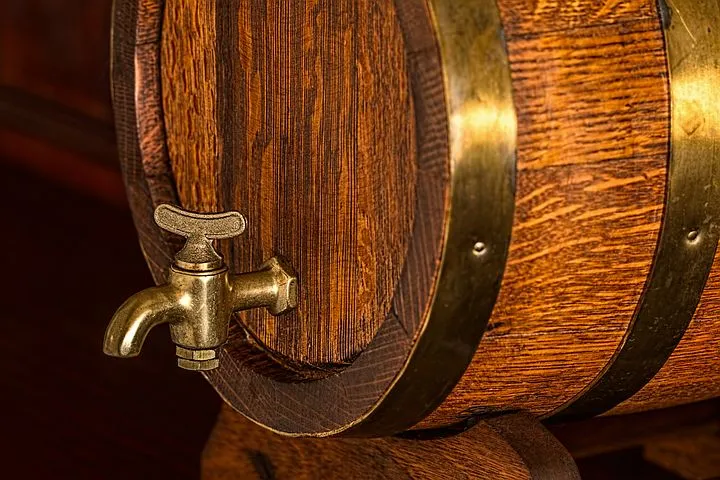Sour beer is a type of craft beer that has become increasingly popular in recent years. While the exact origins of sour beer are unknown, it is thought to date back to ancient times.
Sour beer is made by allowing wild yeast and bacteria to enter the brewing process, which gives the finished product a tart, acidic flavor.
While some people may be put off by the taste of sour beer, there are many health benefits associated with drinking this type of alcohol.
For example, research has shown that drinking sour beers can help improve gut health and digestion.
Additionally, as they are lower in calories than other types of alcoholic beverages, they can also help you stay slim and healthy!
So what exactly are the nutritional facts for sour beers?
Table of Contents:
- What Is Sour Beer?
- The History of Sour Beer
- How Is Sour Beer Made?
- Nutrition Facts for Common Types of Sour Beers
- FAQs in Relation to Sour Beer Nutrition Facts
- Conclusion
What Is Sour Beer?
The sourness comes from the use of wild yeast strains or bacteria, such as Lactobacillus and Pediococcus.
Sour beers are often barrel-aged, which also contributes to their unique flavor profile.
So why would someone want to drink a beer that tastes sour?
Well, for some people, the tartness can be refreshing—kind of like how eating a lemon can make your mouth pucker but then feel refreshed afterward.
And because each batch of sour beer is slightly different (due to variations in ingredients and brewing methods), it can be exciting for craft beer lovers to try new ones and see what they think.
Some popular types of sour beers include Gose, Lambic, Berliner Weisse, and American wild ale.
If you’re thinking about trying out a sour beer but are not sure where to start, our advice would be:
Go for it! Yes, they might taste different from what you’re used to, but part of the fun is exploring all the various flavors that craft beer has to offer.
The History of Sour Beer

Sour beer has a long and storied history, dating back to the Middle Ages. The tart and tangy flavor of sour beer was once a mainstay of European brewing but fell out of favor in the early 20th century as brewers began moving away from traditional styles.
In recent years, however, sour beer has made something of a comeback, with many modern breweries producing their takes on the style.
So what exactly is sour beer?
And how did it come to be?
Let’s take a closer look at the history of this unique beverage. Sour beers are created through spontaneous fermentation – that is, fermentation that occurs naturally without any inoculation by yeast or bacteria cultures.
This process often happens when wild yeast or bacteria enter the worst (unfermented beer) through contact with fruits or other fermentable during open-air brewing sessions known as cool ships.
Once introduced into the worst, these microorganisms go to work eating sugars and creating alcohols and acids, leading to characteristic Sour Beer flavors like citrus, vinegar, funkiness, and more.
Because they rely on chance for successful fermentation, these beers can be difficult (and sometimes unpredictable) to make; which explains why they were largely abandoned by industrial brewers in favor of mass-produced lagers over 100 years ago.
Despite the challenges inherent in their production, Sour Beers have experienced a renaissance in recent years thanks to the craft beer movement.
More and more small breweries are experimenting with spontaneous fermentation, often using locally sourced fruits and other ingredients to create unique flavor profiles.
And as consumers become more adventurous in their tastes, they’re increasingly seeking out these complex and unusual beers.
So if you’re curious about sour beer but haven’t yet taken the plunge, why not give one a try?
With so many flavors and styles available, there’s sure to be something that appeals to your taste buds. And who knows – you may just find yourself becoming a fan of this delicious (and sometimes surprising) beverage!
How Is Sour Beer Made?
Sour beer is made by intentionally allowing wild yeast and bacteria to enter the brew during fermentation.
This can happen through contact with open air, using unwashed brewing equipment, or adding fruits or other ingredients that harbor microorganisms.
The result is a tart, acidic beer with complex flavors.
So how does one make sour beer?
Let’s take a look at the process.
The first step is to create what’s called a starter wort. This is done by boiling water and malt extract together until the mixture thickens and becomes syrupy.
Once this happens, hops are added for bitterness and flavor before cooling it down quickly in an ice bath so that lactobacillus – a type of bacterium – can be introduced without killing it off.
Lactobacillus plays an important role in giving sour beers their characteristic tangy taste.
Once the wort has cooled, it’s time to add the yeast. For sour beers, brewers will often use a mix of different yeast strains including Saccharomyces, Brettanomyces, and Lactobacillus.
This combination can be achieved by reusing yeast from a previous batch of sour beer or purchasing a commercial blend designed specifically for this style of beer.
After adding the yeast, fermentation will begin and continue for several weeks or even months, depending on the desired outcome.
During this time, you may notice that foam starts to form on top of the fermenting beer – this is normal! As fermentation progresses, taste testing is important so that adjustments can be made if necessary (for example: More malt extract could be added if sweetness is desired). When all is said and done and final touches have been made according to taste preference (e.g., adding fruit juices), your homemade sour beer will be ready to enjoy!
Nutrition Facts for Common Types of Sour Beers

Sour beers have become increasingly popular in recent years, as craft beer drinkers have been seeking out new and interesting flavors.
While traditional styles of sour beer can be traced back centuries, modern brewers are experimenting with all sorts of ingredients and techniques to create unique takes on the style.
If you’re a fan of sour beers or are simply curious about them, you may be wondering about their nutritional content. Here’s a look at some common types of sour beers and their nutrition facts.
Lambic: Lambic is a type of spontaneously fermented Belgian beer that has a distinctive tart flavor.
It is typically low in alcohol, around 4-6% ABV, and contains around 160 calories per 12 oz serving. Iambics also tend to be high in carbohydrates (around 25 g per 12 oz serving) due to the use of unmalted wheat in the brewing process.
However, they are relatively low in protein (1-2 g per 12 oz serving) and fat (0-1 g per 12 oz serving).
Gose: Gose is a German style of sour beer that is typically brewed with salt and coriander. It is usually around 4-5% ABV and contains around 150 calories per 12 oz serving.
Goses tend to be relatively low in carbohydrates (around 10-15 g per 12 oz serving), as well as protein (1-2 g per 12 oz serving) and fat (0-1 g per 12 oz serving).
Berliner Weisse: Berliner Weisse is another German style of sour beer, which gets its tart flavor from the use of lactobacillus during fermentation. It tends to be fairly light, with an alcohol content of 3-4% ABV and contains around 140 calories per 12 oz serving.
Like other sours, Berliner Weisse is also low in carbohydrates (10-15 g per 12 oz serve) but higher in protein (3-4g12oz serve) due to the use of wheat malt. They are also very low in fat, with 0 grams present per 12 oz serving size.
That concludes our look at nutrition facts for common types of sour beers!
As you can see, these beers are generally quite low in calorie and carbohydrate content – making them a great choice if you’re watching your weight or trying to limit your intake of processed sugars.
However, they are higher in protein than most other styles of beer, so if you’re following a vegan or vegetarian diet, you’ll want to check the labels carefully.
And finally, while sour beers tend to be low in alcohol content, there are some exceptions – so always drink responsibly!
FAQs in Relation to Sour Beer Nutrition Facts
Is there a lot of sugar in sour beer?
Sour beer generally has a lower sugar content than other types of beer, due to the fermentation process. However, there may still be some residual sugars present in the final product.
The exact amount will vary depending on the recipe and brewing method used. For example, some sour beers may be bottle-conditioned, meaning that they contain live yeast, which can continue to ferment any residual sugars present.
Overall, though, sour beer is not a particularly sweet beverage, and it is not a particularly sweet beverage.
Is sour beer healthier than regular beer?
There is no definitive answer to this question, as the health benefits of sour beer depend on a number of factors, including the specific ingredients used and how the beer is brewed.
However, some research suggests that sour beer may offer certain health benefits due to its probiotic content and lower alcohol content.
Probiotics are live bacteria that are beneficial for gut health, and they have been linked with improved digestion, immune function, and mental health.
Additionally, since sour beers generally contain less alcohol than regular beers (due to their higher acidity), they may be easier on your liver and provide fewer calories overall.
Are sour beers more healthy?
There is no definitive answer to this question as the health benefits of sour beer depend on a number of factors, including the specific ingredients used and how they are brewed.
However, some studies have shown that sour beers may offer certain health benefits due to their probiotic content and lower alcohol levels.
Probiotics are beneficial bacteria that can help improve gut health, and low-alcohol beers typically contain fewer calories than regular beers. Therefore, if you’re looking for a healthier option, sour beer could be a good choice.
How many carbs are in sours?
The answer to this question depends on the specific beer in question, as nutritional information can vary from one brand or type of sour beer to another. However, in general, sours tend to be relatively low in carbohydrates.
This is due largely to the fact that sour beers are often made with fruit juices and other fermentable which contribute very little sugar carbohydrate content to the final product.
For example, a typical 12-ounce serving of Flanders red ale has only about 5 grams of carbs per bottle – significantly lower than most other types of beer (which often have upwards of 20 grams or more).
So if you’re watching your carb intake, sours may be a good option for you.
Conclusion
Overall, sour beers are a healthy option if you’re looking for something to drink. They’re lower in calories and full of probiotics, which can help improve gut health.
So next time you see a sour beer on the menu, don’t be afraid to give it a try!
Welcome to Brew Publik! We are your one-stop shop for all things beer. We offer a variety of services, including beer reviews, beer equipment, and beer subscription services. We also have a wide selection of beers available for purchase.
Whether you are a beginner or an experienced brewer, we have the perfect solution for you. Contact us today to learn more about our services and how we can help you make the perfect batch of beer.

